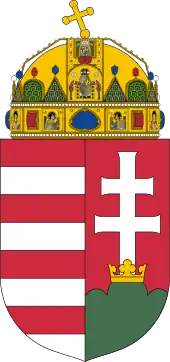| ||||||||||||||||||||||
Do you want the president of the republic to be elected directly? | ||||||||||||||||||||||
| Outcome | Proposal failed due to low voter turnout | |||||||||||||||||||||
|---|---|---|---|---|---|---|---|---|---|---|---|---|---|---|---|---|---|---|---|---|---|---|
| Results | ||||||||||||||||||||||
| ||||||||||||||||||||||
 |
|---|
A referendum on introducing direct elections for the Presidency was held in Hungary on 29 July 1990.[1] Although the proposal was supported by 85.9% of voters, turnout was just 14%, resulting in the referendum being declared invalid.[2] As a result, the President continued to be elected by the National Assembly.
Results
| Choice | Votes | % |
|---|---|---|
| For | 926,823 | 85.9 |
| Against | 152,076 | 14.1 |
| Invalid/blank votes | 9,069 | – |
| Total | 1,087,968 | 100 |
| Registered voters/turnout | 7,820,161 | 14.0 |
| Source: Nohlen & Stöver | ||
References
- ↑ Dieter Nohlen & Philip Stöver (2010) Elections in Europe: A data handbook, p899 ISBN 978-3-8329-5609-7
- ↑ Nohlen & Stöver, p912
This article is issued from Wikipedia. The text is licensed under Creative Commons - Attribution - Sharealike. Additional terms may apply for the media files.